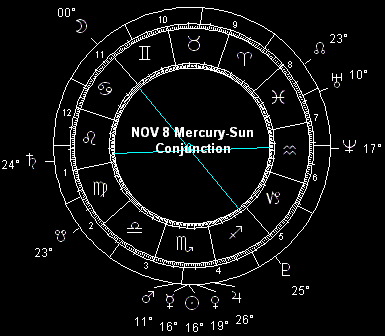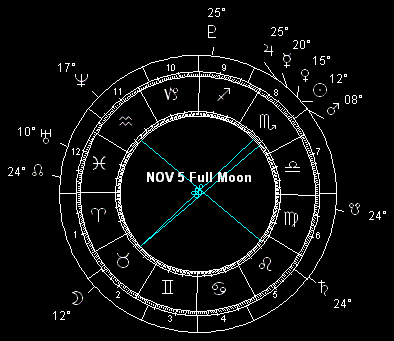If you were expecting some kind of sun sign nonsense, forget about it. This is real astrology for the real world. If it's real astrology for yourself that you want, you can get it by phone or in print. And if you need help deciphering the astrological glyphs in the graphics accompanying this article, see Astroglyphs: Astrological Symbols Guide. Please note: this forecast is expressed in terms of Universal Time (UT).
Predicting the future is easy. It's trying to figure out what's going on now that's hard.
-- Fritz R. S. Dressler
 November is largely about follow-throughs and hangers-on from October - until near the end of the month at any rate, when Jupiter changes sign (from Scorpio to Sagittarius) and the Mercury and Uranus retrogrades end. Among the notable carry-overs from last month is the exceptional Mercury intersolar cycle, which lasts until the 27th and includes a rare Mercury transit across the solar disk. The 2006 signature Jupiter-Saturn-Neptune T-square loosens up this month, slipping out of a few degrees of exact (partile) aspect for the first time since July. But as Yogi said, "it ain't over 'til it's over" - and it ain't over yet. With Mercury, Venus, the Sun and Mars all forming hard aspects to one or more of the T-square planets this month - a kind of rolling activation of the pattern - the configuration remains sensitive throughout November.
November is largely about follow-throughs and hangers-on from October - until near the end of the month at any rate, when Jupiter changes sign (from Scorpio to Sagittarius) and the Mercury and Uranus retrogrades end. Among the notable carry-overs from last month is the exceptional Mercury intersolar cycle, which lasts until the 27th and includes a rare Mercury transit across the solar disk. The 2006 signature Jupiter-Saturn-Neptune T-square loosens up this month, slipping out of a few degrees of exact (partile) aspect for the first time since July. But as Yogi said, "it ain't over 'til it's over" - and it ain't over yet. With Mercury, Venus, the Sun and Mars all forming hard aspects to one or more of the T-square planets this month - a kind of rolling activation of the pattern - the configuration remains sensitive throughout November.
The cultural, political and economic dimensions of the Jupiter-Saturn-Neptune T-square have already been described in some detail. I don't think there can be much argument that under the aegis of this configuration, there has been "a crisis of confidence, a loss of faith in authority and tradition" all 'round the globe. If the US mid-term elections turn out badly for the GOP, it will be all too clear that the T-square and the world are in synch. And that's just one particular US political expression of the phenomenon. Look around you, and there's a world more of the same to see. But this is not a case of one side dominating the other: neither side can win outright, each only wears the other down to the point that compromise by attrition and exhaustion is the ultimate outcome.
If you've followed my monthly forecasts this fall, you know I've been expecting a downturn in major equity markets. The peak I expected in September - thank you, Fritz Dressler - took a few more weeks to top out, by and large; but as October drew to a close, it appeared that profit-taking had finally set in. While I expect normal daily ups and downs along the way, everything I see points to an over-all downward trend in November: the Venus-Neptune square on the 7th and Mercury solar transit on the 8th, the mid-month Venus hard aspects to Jupiter and Saturn (the other two T-square participants, in addition to Neptune which was aspected by Venus a week prior), and Saturn coming to within minutes of its December 6 retrograde station as Mars squares the Ringed Planet at the end of the month.
That Mars square (exact on the 29th, within a few degrees from the 23rd on into December) is a danger signal, a sign of stress and strife and hurt. Accidents, fires, criminality, terrorism and military conflict are off-and-on risks both around mid-month and late in November. This isn't Armageddon-type stuff, but it's locally and personally ugly here and there.
 Speaking of accidents, virtually the entire month falls under the aegis of Mercury's intersolar cycle, which began in mid-October as the little sun-grazer reached its maximum elongation east of Sol. It's a cycle that includes the October 28-November 18 retrograde of Mercury as well as the uncommon Mercury transit of the Sun on the 8th - the first one since 2003 - and concludes with the little planet's November 25 western elongation extreme.
Speaking of accidents, virtually the entire month falls under the aegis of Mercury's intersolar cycle, which began in mid-October as the little sun-grazer reached its maximum elongation east of Sol. It's a cycle that includes the October 28-November 18 retrograde of Mercury as well as the uncommon Mercury transit of the Sun on the 8th - the first one since 2003 - and concludes with the little planet's November 25 western elongation extreme.
A Mercury transit across the solar disk is a rare and special kind of inferior conjunction. All inferior conjunctions occur when Mercury passes directly between Earth and Sun. (A superior conjunction, on the other hand, takes place when Earth, Sun and Mercury are aligned with Mercury on the far side of the Sun from us.) If Earth and Mercury orbited in the same plane, every inferior conjunction would be a solar transit. However Mercury's orbit is inclined by seven degrees to Earth's orbital plane (viz. the ecliptic), so it's the rare inferior conjunction which takes place with Earth and Mercury being in the same plane at the same time they're lined up with the Sun. In a typical year, there are three inferior conjunctions of Mercury and the Sun. In a typical century, out of several hundred of those inferior conjunctions, there are only about thirteen solar transits of Mercury.
Since Columbus set sail for the Americas, and for the next 1,500 years or so, solar transits of Mercury can only occur in May and November. Currently, the May transit happens around the 8th - its aphelion transit, when Mercury is farthest from the Sun. The November transit occurs around the 11th - it's the perihelion transit, when Mercury is nearest the Sun. Nowadays, those dates put the solar transit around the middle of the fixed signs Taurus and Scorpio, respectively. (November transits recur at intervals of 7, 13 or 33 years; while May transits recur at intervals of 13 or 33 years.)
This year's transit takes place during the November 8 inferior conjunction, at 16° 20' Scorpio; which just happens to be in the range of the year's hallmark T-square. It belongs to a series of 19 Mercury transits which began in 1776 and concludes in 2604, according to a system expounded by NASA astrophysicist Fred Espenak. (Espenak's system is analogous to the Saros Cycle, but applies to Mercury transits instead of eclipses.) There was a solar transit in this series on November 7, 1914 - nine days before the US Federal Reserve opened for business. Although there have been thirteen Mercury transits between then and now, only one belonged to the same series as the 2006 event. It happened on November 7, 1960 - within a day of the US Presidential election that put John Kennedy in the White House. Controversial political and economic watersheds, now as then? You bet!
 I figure that the rare solar transit makes this year's October 17-November 25 intersolar Mercury cycle especially dramatic. It heralds labor strife (strikes, pickets, etc.), infrastructure breakdowns and accidents (including power, rail, highways, air travel and satellite systems - possibly with a solar-induced geomagnetic activity component); automatic system failures (including safety systems in vehicles, aircraft, and marine vessels); and most especially computer-related messes (from hacker attacks and network outages to software flaws to lawsuits and other legal actions against computer hardware and software makers). True, these things are not uncommon anytime Mercury is intersolar. We're just due for a bigger, 'badder' batch this time around. In particular, watch for (and guard against) major Murphy's Law stuff around the full moon on the 5th, with its Sun-Mercury-Venus-Mars-Jupiter stellium in Scorpio and of course the year's big T-square still hanging around. (Don't be surprised by a big drop in the US dollar versus the Euro and other currencies sometime between about November 4 and the end of the year.)
I figure that the rare solar transit makes this year's October 17-November 25 intersolar Mercury cycle especially dramatic. It heralds labor strife (strikes, pickets, etc.), infrastructure breakdowns and accidents (including power, rail, highways, air travel and satellite systems - possibly with a solar-induced geomagnetic activity component); automatic system failures (including safety systems in vehicles, aircraft, and marine vessels); and most especially computer-related messes (from hacker attacks and network outages to software flaws to lawsuits and other legal actions against computer hardware and software makers). True, these things are not uncommon anytime Mercury is intersolar. We're just due for a bigger, 'badder' batch this time around. In particular, watch for (and guard against) major Murphy's Law stuff around the full moon on the 5th, with its Sun-Mercury-Venus-Mars-Jupiter stellium in Scorpio and of course the year's big T-square still hanging around. (Don't be surprised by a big drop in the US dollar versus the Euro and other currencies sometime between about November 4 and the end of the year.)
Contributing to the potential for infrastructure messes is the full moon on the 5th, part and parcel of a series of geophysical stress indicators in effect from the 1st through the 10th; including the Moon's northward equatorial crossing on the 2nd, the lunar perigee (closest approach to Earth) on the 3rd, and the lunar north declination maximum on the 8th. This entire period is one when strong storms with high winds and heavy precipitation will work their destructive magic on the works of humankind - including the transportation system. Moderate to severe (Richter 5+) earthquakes and volcanic eruptions are also emphasized during this cycle. Mid-month presents another blip on the storm and seismic screen, but a longer geocosmic stress window opens up on the 17th in advance of the new moon on the 20th, and continues into the 24th. Last but hardly least is the storm and seismic activity upsurge from November 28 through December 3. With all these risk windows, it pays to be prepared, to have foul weather gear and plans handy, to have your emergency kit checked and ready.
 SPECIAL FEATURE: This month's birthdays of the famous and infamous (with astrological birth charts)
SPECIAL FEATURE: This month's birthdays of the famous and infamous (with astrological birth charts)